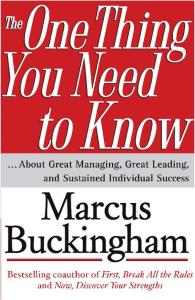Marcus Buckingham spent 17 years at Gallup, with teams testing millions of people on various issues. One project began to zero in on what they called “The One Thing.” This asked what one factor above all others makes people
- great leaders,
- great managers,
- great employees or
- one factor that singled out and predicted successful relationships.
 Gallup has massive amounts of data and the ability to crunch it.
Gallup has massive amounts of data and the ability to crunch it.
In good relationships, people give the other person the benefit of the doubt. They assume that their spouse, significant other, friend or whoever has the best intentions, and means well, no matter how many other possible (negative) interpretations exist. They “intentionally wear rose-colored glasses.”
A critical issue is the mechanism at work. In human relationships, we fill communication gaps with material of our own invention, and this is usually drawn from our personal baggage collection.
Check your baggage collection. If you are even vaguely normal, you carry a large bag of negative, painful stuff, held together by the world’s efforts to lower your self-esteem.
Spouses or partners, friends or family usually mean well but in some instances this is not so, so trust but verify. Once satisfied that trust is deserved, the team found that the “rose colored glasses” approach very often causes a self-fulfilling prophecy phenomenon to kick in. Especially in close relationships, the other lifts his/her game to meet the expectations of his/her partner. An upward spiral is created.
Of course an loser, abusive partner will not suddenly become fantastic if you expect the best of him/her. We’re talking about research that applies to good relationships.
Life is full of communication gaps, so there are plenty of opportunities for people to experience these and to fill them with negative interpretations. It’s easy to fill a gap with frustration, anger, fear or self-doubt. It’s easy to take offense quickly, and to develop an interior monologue, or create a chain of assumptions. Each assumption builds on the previous one, which is then treated as a fact, and becomes the basis for another assumption, which is treated as fact in its turn. We rapidly create a narrative about a situation, in which the other person’s actions, motivation, and character feel like an attack on us.
The solution
Imagine that your partner or a friend comes in and hardly talks to you, or uses an abrupt or harsh tone. You assume you are in trouble. What did you do? The old voices clamor in your head, and an internal scenario appears in your mind.
Yet there are 1000 reasons for the other person’s behavior. In my case, I probably have a headache. Or a new idea or preoccupation. That RFP is getting to me. I was texting or reading something. I misinterpreted what you wanted. ….so on and so on.
Ask. Ask, with the assumption that the misunderstanding can and should be clarified, and the relationship is strong and both parties have good intentions.
“You sounded a bit stressed when I asked you about XYZ. Is everything okay? Can we take a few minutes to discuss and resolve this?”
“Yes, I was abrupt. Jon called and said that there are a lot of vendors for the RFP we’re hoping to get. I keep going over the final numbers and worrying whether I asked for too much. Thanks so much for noticing – I think a hug and some tea would help.”
Wait. Some people are fast-paced and verbal, others not so much. Those of us who are verbal can easily overwhelm the more introverted, reflective or less verbal partner in a relationship.
A question often needs wait time before the answer comes. Body language will help to show whether you are open to any answer, and have the patience and a positive willingness to hear it.
Listen: You’re interested in hearing the other person’s position, understanding and supporting them, not in winning, being right or one-upmanship. You assume that they have good intentions, and are on your side. Listen to hear the good intentions, not to support negative assumptions or to encourage self-created scenarios that have intruded from past baggage.
Buckingham, Gallup and the school of Positive Psychology (led by Martin Seligman etc) have grown interest in emphasizing strengths, positives and happiness. This is all based on empirical research. The work holds new paths to successful organizations and better relationships.

